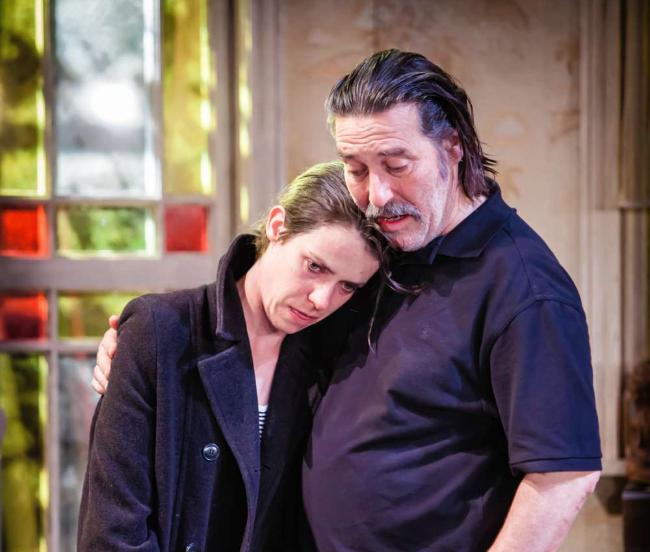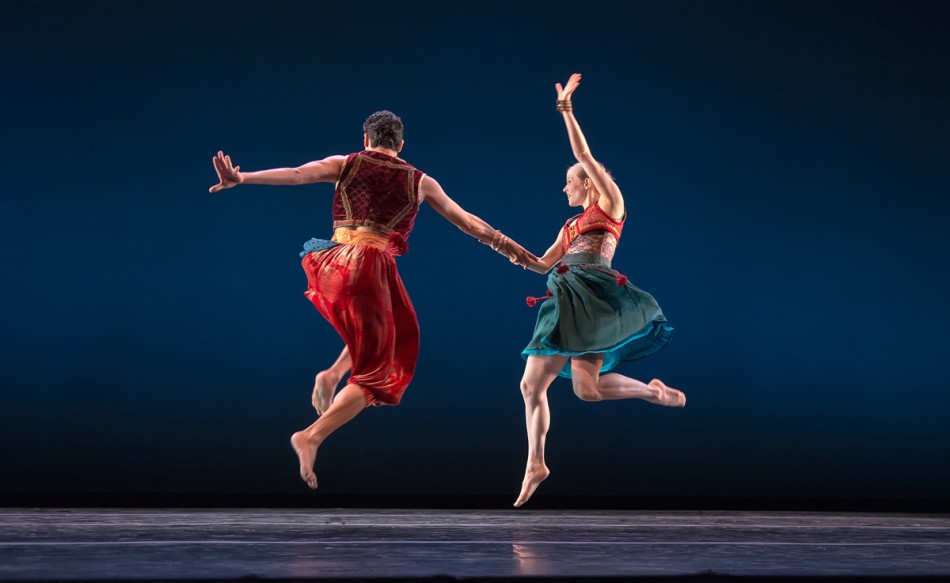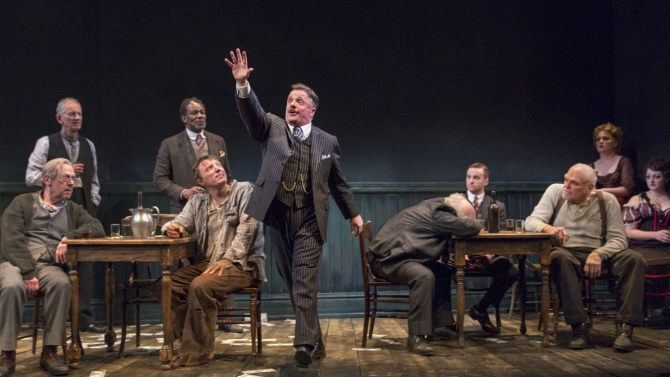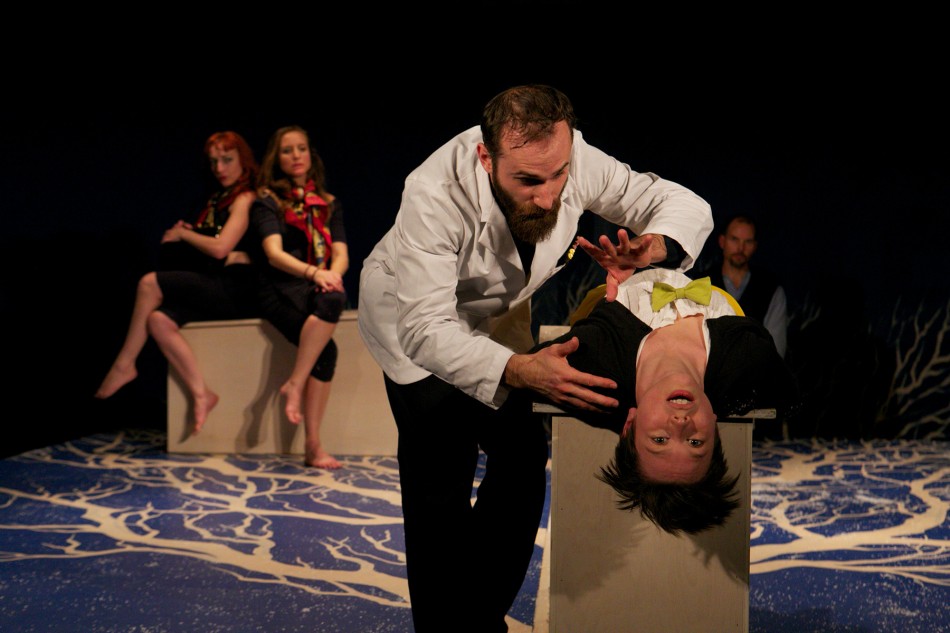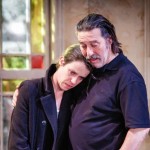

Dunne & Hinds
by: Marilyn Lester
Like smooth, fine whiskey and exquisitely knit Aran sweaters, Dublin-born playwright Conor McPherson is an Irish treasure – arguably one of the best playwrights of his or any generation. In The Night Alive, a production originally mounted at the Donmar Warehouse, McPherson scores another bulls eye, adding to an impressive roster of works including The Wier, Shining City and The Seafarer.
In a darkened, shadowy, cluttered room, Maurice (Jim Norton), stands in his robe and pajamas, staring motionless at nothing in particular. Seconds after he exits, Tommy (Ciarán Hinds) and Aimee (Caoilfhionn Dunne) noisily burst in through a set of French doors. Tommy, Maurice’s nephew, has gone out late for a packet of chips, and has rescued Aimee from an assailant on the street. Her wounded head is wrapped in his jacket.
Tommy’s first problem is light, specifically the lack of it. In this unmodernized Edwardian house the meter has run out and Tommy has no change for the coin box. But it’s obvious Tommy’s been in this situation before. There’s a hammer strategically placed to pry the box open, retrieve the coins, and feed the meter. (Chekhovian spotlight on the hammer; it will be used later to wreak havoc). With the lights back on, Tommy can now see the extent of the damage to Aimee’s head and properly care for the wound.
This metaphoric interaction between light and dark is the engine that drives The Night Alive. Just as Maurice is first seen in shadows, the shadow self of each character is exposed to the light and examined with acute precision in a masterful economy of words. McPherson (who also directed) is at his most focused here, relentlessly scrutinizing this group of emotional cripples who live near Dublin’s Phoenix Park – the allusion being to the mythical bird who periodically dies in fire and is resurrected anew from the ashes of its pyre.
Tommy, the focal point of The Night Alive, is a paunchy, middle-aged chancer who rents a room from his uncle Maurice. With his slovenly dress and long, greasy hair, Tommy is doing no more than biding time, Raised by the childless Maurice and his wife, Maura, now three years dead, he’s come back “home” after leaving a failed marriage and two kids behind. Like Tommy, the room is in a state of chaos, the detritus of his life strewn everywhere.
On the morning after the incident, Doc (Michael McElhatton), arrives for work. He’s Tommy’s cohort and helper. Tommy owns a van and the two of them make a living by performing a variety of odd jobs. Doc is surprised when Aimee appears, her head in a towel. In this old house, the hot water has gone out just as she’s about to rinse her shampooed hair. Tommy assures her the immersion (the boiler) will warm it up again soon.
Doc, we eventually learn, may seem dim, but like the wise fool, knows a thing or two. One thing he knows straight off is that Aimee is trouble. The lads down the pub have pointed her out and told him that she’s “on the game” – a prostitute. If we haven’t figured it out already, it’s clear now that Aimee comes with a lot of baggage. In introducing Aimee to Doc, his status as an emotional cripple is confirmed. Tommy describes his friend as “disabled,” meaning he’s about 10 minutes behind everyone else in picking up on things.
Aimee stays on with Tommy and a relationship develops. This state of affairs causes disruption for Doc, who has no place of his own and often stays with Tommy on the camp bed (he’s constantly being thrown out of his sister’s house). The rhythm of Maurice’s life is also disrupted by Aimee’s presence in what he clearly makes known as his house. Like his ancient house, Maurice is a dying breed of Irish man – raised in the morality of a disempowered Church, and uncomfortable in a changed, modern world. Maurice frequently comes down to Tommy’s room to give instructions and pronounce various judgments. When Maurice confronts Tommy about his relationship with Aimee, for instance, he reminds him he’s a married man. It’s no matter that Tommy’s marriage is over; to Maurice, “marriage is marriage.”
One night, as Aimee, Tommy and Doc hang out, Tommy turns on a recording of Marvin Gaye’s “What’s Going On.” What is going on, Tommy asks as the three prance around the room giddily gyrating to the music, “that is the question.” The moment is comic, as it has to be, for truth be told, no one has the answer to that impossible conundrum and only a bit silliness will do.
As fate would have it on this night, Tommy and Aimee go out to check the lotto numbers, leaving Doc alone. Enter Kenneth (Brian Gleeson), Aimee’s former boyfriend, and, it is revealed, the one who beat her on the night of the rescue. Kenneth is an unstable ne’er-do-well emanating danger with every breath. He stalks Doc around the room, picking up the hammer and flirting with it mercilessly. Finally he corners Doc and attacks him out of sight of the audience. As in the darkness of night, we can’t see what’s happening, but the sounds are horrifying, and Doc’s fate isn’t immediately revealed.
Kenneth is not done with Aimee, though, and like the bad penny he is, soon turns up again to make trouble. Tommy is having none of it. There’s a scuffle and suddenly Kenneth lies dead with a knife stuck in his back. In the panic that follows, Tommy decides they’ll get rid of the body (people just disappear all the time, he says) and make their way with the van to Finland. In Tommy’s mind, Finland is the beacon of light beckoning he and Aimee out of their dire situation; yet in truth, what will meet them there is unrelenting night for much of the year.
The Finnish scheme never comes to fruition. With the problem over – Kenneth has been successfully buried in the countryside – Aimee balks at leaving, and abandons Tommy. He knows he’s back on his own now. To make matters worse, soon after Aimee’s exit, Maurice stumbles into Tommy’s room drunk and enraged. Preoccupied with Kenneth’s body, Tommy has missed his Aunt Maura’s funeral mass. When the grief-stricken Maurice tells Tommy only three people showed up at the church, he weeps, “Three people. Is that what a life is worth?”
Just as Tommy wondered earlier, what’s going on? the fragility of the characters in The Night Alive is never more apparent than at this point in the play. When Maurice sobers up he tells Tommy “You only get a few goes at life. You don’t get endless goes. Two, three goes maybe. When you hit the right groove you’ll click right in there… this is it.”
Doc, who’s alive and has been released from the hospital, turns up with another clue to the inscrutable meaning of life. He’s had a dream, he tells Tommy, in which an otherworldly guide has explained many things to him, including the mystery of gravity and black holes (alluded to earlier in the play). The black hole, an endless night, he says, sucks everything into it.
The damaged souls who inhabit The Night Alive might well wonder if and when life is going to click into place. Just when Tommy is resolved to carry on as before, Aimee returns. In an unexpected moment, as he’s dressing to go out, Aimee enters through the French doors and sits on the camp bed, facing Tommy. He stares at her in wonderment. This is the moment of hope and possible redemption. Now it’s anybody’s guess as to what will happen next.
The atmospheric and subtle lighting of The Night Alive was designed by Neil Austin. Sets and costumes are by Soutra Gilmour, and sound by Gregory Clarke. J. David Brimmer is the violence consultant, and production stage manager is Mary Kathryn Flynt
The Night Alive runs at the Atlantic Theater Company’s Linda Gross Theater, 336 West 20th Street, until January 26, 2014. Tickets by phone at 866-811-4111 or at www.atlantictheater.org.
*Photos: Helen Warner


